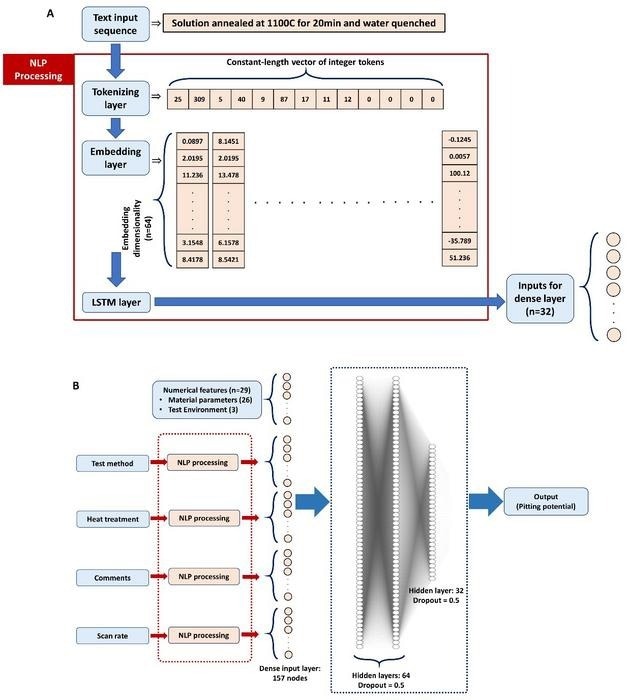In a world where annual corrosion economic losses exceed 2.5 trillion US dollars, the search for corrosion-resistant alloys and protective coatings continues to persist. Artificial intelligence (AI) is becoming increasingly important in the design of new alloys.
 (A) Schematic representation of the entire process-aware deep neural network model. (B) Schematic illustration of the data processing workflow carried out within the natural language processing (NLP) module. Image Credit: Science Advances
(A) Schematic representation of the entire process-aware deep neural network model. (B) Schematic illustration of the data processing workflow carried out within the natural language processing (NLP) module. Image Credit: Science Advances
However, the predictive power of AI models to determine corrosion behavior and recommend optimal alloy formulas has remained elusive. Researchers at the Max-Planck-Institut für Eisenforschung (MPIE) have created a machine learning model that improves predictive accuracy by up to 15% over existing frameworks.
This model identifies new but feasible corrosion-resistant alloy compositions. Its unique power stems from the combination of numerical and textual data. This model’s adaptability can be augmented to all alloy properties after it was initially developed for the crucial realm of resisting pitting corrosion in high-strength alloys. The latest findings were published in the journal Science Advances.
Merging Texts and Numbers
Every alloy has unique properties concerning its corrosion resistance. These properties do not only depend on the alloy composition itself but also on the alloy’s manufacturing process. Current machine learning models are only able to benefit from numerical data. However, processing methodologies and experimental testing protocols, which are mostly documented by textual descriptors, are crucial to explain corrosion.
Kasturi Narasimha Sasidhar, Study Lead Author and Former Postdoctoral Researcher, Max-Planck-Institut für Eisenforschung
The study team created a completely automated natural language processing framework by combining language processing techniques similar to ChatGPT with machine learning (ML) methods for numerical data. Additionally, incorporating textual data into the ML framework enables the identification of improved alloy compositions resistant to pitting corrosion.
We trained the deep-learning model with intrinsic data that contain information about corrosion properties and composition. Now the model is capable of identifying alloy compositions that are critical for corrosion-resistance even if the individual elements were not fed initially into the model.
Michael Rohwerder, Study Co-Author, Max-Planck-Institut für Eisenforschung
Michael Rohwerder is the head of the group Corrosion.
Pushing Boundaries: Automated Data Mining and Image Processing
Sasidhar and his group used manually collected data as textual descriptors in the recently developed framework. Their current goal is to automate the data mining process and seamlessly incorporate it into the current framework. Another significant development is the addition of microscopy images, which foresees the next generation of AI frameworks that combine textual, numerical, and image-based data.
Journal Reference:
Sasidhar, K. N., et al. (2023) Enhancing corrosion-resistant alloy design through natural language processing and deep learning. Science Advances. doi.org/10.1126/sciadv.adg7992.